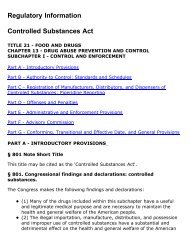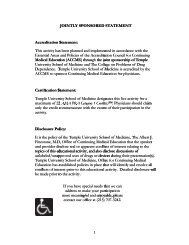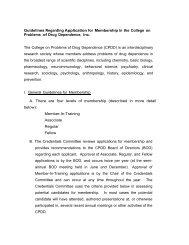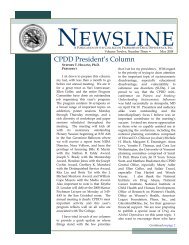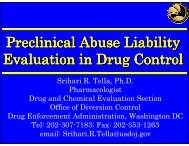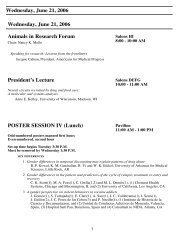CPDD 72nd Annual Meeting • Scottsdale, Arizona - The College on ...
CPDD 72nd Annual Meeting • Scottsdale, Arizona - The College on ...
CPDD 72nd Annual Meeting • Scottsdale, Arizona - The College on ...
Create successful ePaper yourself
Turn your PDF publications into a flip-book with our unique Google optimized e-Paper software.
13<br />
REDUCED-NICOTINE CONTENT CIGARETTES:<br />
KNOWLEDGE, ATTITUDES AND PRACTICE IN DRUG-<br />
DEPENDENT PREGNANT AND POST-PARTUM SMOKERS.<br />
Allan M Andersen, F Yunus, M Chisolm; Psychiatry, Johns Hopkins University<br />
School of Medicine, Baltimore, MD<br />
Aims: To determine the knowledge, attitudes, and practice of reduced-nicotine<br />
c<strong>on</strong>tent (RNC) cigarettes in drug-dependent pregnant and post-partum smokers.<br />
Methods: Participants were N=26 drug-dependent, cigarette-smoking patients<br />
at the Center for Addicti<strong>on</strong> and Pregnancy (CAP). Participants completed an<br />
an<strong>on</strong>ymous survey regarding RNC cigarettes. Study was approved by the local<br />
Instituti<strong>on</strong>al Review Board.<br />
Results: 43% of CAP patients completed the survey. <str<strong>on</strong>g>The</str<strong>on</strong>g> majority of participants<br />
reported currently being pregnant (85%) and methad<strong>on</strong>e-maintained<br />
(92%). Mean (SD) admissi<strong>on</strong> durati<strong>on</strong> (days)=73 (75). Mean (SD) reported cigarettes<br />
per day=12 (8), and 42% of participants reported current or past use of<br />
at least <strong>on</strong>e anti-smoking medicati<strong>on</strong>, most comm<strong>on</strong>ly the nicotine patch (35%),<br />
followed by nicotine gum (19%), and bupropi<strong>on</strong> (15%). A majority (88%)<br />
reported current interest in quitting smoking. Patients dem<strong>on</strong>strated a general<br />
lack of knowledge about RNC cigarettes, but most (69%) were interested in<br />
learning more about them. Although few patients (4%) reported previous use of<br />
RNC cigarettes, 60% reported interest in trying them, and 68% believed RNC<br />
cigarettes were at least as safe if not safer than regular cigarettes.<br />
C<strong>on</strong>clusi<strong>on</strong>s: Given the high prevalence of cigarette smoking in drug-dependent<br />
pregnant women, there is a need to develop novel treatment strategies in this<br />
populati<strong>on</strong>. Because nicotine is a known teratogen and because psychological<br />
factors play a greater role in c<strong>on</strong>tinued cigarette use in women than men, RNC<br />
cigarettes may have a role to play in helping pregnant smokers quit. <str<strong>on</strong>g>The</str<strong>on</strong>g>se findings<br />
suggest that the majority of cigarette-smoking drug-dependent perinatal<br />
patients view the use of RNC cigarettes as an appealing approach to aid cessati<strong>on</strong>.<br />
In light of these findings and the Food and Drug Administrati<strong>on</strong>’s new<br />
authority to regulate tobacco products, further studies of RNC cigarettes in this<br />
populati<strong>on</strong> are needed.<br />
Financial Support: n<strong>on</strong>e<br />
15<br />
ESTIMATION OF A HUMAN SATIETY THRESHOLD FOR<br />
COCAINE SELF-ADMINISTRATION.<br />
Gustavo A Angarita 1 , R Gueorguieva 1,2 , B Pittman 1 , R Kalayasiri 3 , W L Lynch 4 ,<br />
A Sugh<strong>on</strong>dhabirom 3 , P T Morgan 1 , R T Malis<strong>on</strong> 1 ; 1 Psychiatry, Yale University,<br />
New Haven, CT, 2 Divisi<strong>on</strong> of Biostatistics, Yale University, New Haven, CT,<br />
3 Psychiatry, Faculty of Medicine, Chulal<strong>on</strong>gkorn University, Bangkok, Thailand,<br />
4 Psychiatry and Neurobehavioral Sciences, University of Viriginia School of<br />
Medicine, Charlottesville, VA<br />
Aims: Preclinical work in rodents by Tsibulsky and Norman(1999) have suggested<br />
a model of self-regulated cocaine intake. Central to this model is the c<strong>on</strong>cept<br />
of a “satiety threshold,” a bodily amount of cocaine above which the probability<br />
of self-administrati<strong>on</strong> is low. Given assumpti<strong>on</strong>s of first-order cocaine<br />
kinetics, they describe an equati<strong>on</strong> relating inter-infusi<strong>on</strong> intervals (T) for selfadministered<br />
unit cocaine doses (DU), drug half-life (t 1⁄ 2), and the total amount<br />
of cocaine at the satiety threshold (DST), as follows:<br />
T=ln(1+DU/DST)�t 1⁄ 2/ln2. <str<strong>on</strong>g>The</str<strong>on</strong>g> current study aimed to estimate a human DST<br />
based <strong>on</strong> a retrospective analysis of human self-administrati<strong>on</strong> data.<br />
Methods: 31 n<strong>on</strong>-treatment seeking, cocaine dependent subjects participated in<br />
three self-regulated, 2-hour cocaine self-administrati<strong>on</strong> sessi<strong>on</strong>s under a fixedratio<br />
1: 5-min timeout schedule. For each unit cocaine dose (8, 16, and 32<br />
mg/70kg), mean ± SD (i.e., group), inter-infusi<strong>on</strong> interval data were obtained.<br />
By fixing the values of t 1⁄ 2 for cocaine between 45 and 60 minutes, n<strong>on</strong>-linear fits<br />
enabled estimates of a human satiety threshold.<br />
Results: Mean ± SD inter-infusi<strong>on</strong> intervals of 13 ± 8, 16 ± 10, and 19 ± 14<br />
minutes were obtained for the 8, 16, and 32mg/70kg unit doses, yielding an estimated<br />
human DST ranging from 69.5 to 97.3 mg/70 kg.<br />
C<strong>on</strong>clusi<strong>on</strong>s: To our knowledge, these data are the first to describe an amount<br />
of cocaine in humans at which satiety is predicted. In analogy to prior rodent<br />
studies (Norman and Tsibulsky, 2006) experimental work (now underway) is<br />
needed to verify the validity of these estimates.<br />
Financial Support: NIDA (R01 DA15857, K24 DA017899)<br />
NIMH (R25 MH071584)<br />
CT Department of Mental Health and Addicti<strong>on</strong> Services<br />
NCRR (UL1RR024139)<br />
<str<strong>on</strong>g>CPDD</str<strong>on</strong>g> <str<strong>on</strong>g>72nd</str<strong>on</strong>g> <str<strong>on</strong>g>Annual</str<strong>on</strong>g> <str<strong>on</strong>g>Meeting</str<strong>on</strong>g> <str<strong>on</strong>g>•</str<strong>on</strong>g> <str<strong>on</strong>g>Scottsdale</str<strong>on</strong>g>, <str<strong>on</strong>g>Ariz<strong>on</strong>a</str<strong>on</strong>g><br />
4<br />
14<br />
MOTIVATIONS NOT TO DRINK ALCOHOL IN<br />
ADOLESCENCE.<br />
Kristen G Anders<strong>on</strong>, I Grunwald, A Grant; Psychology, Reed <str<strong>on</strong>g>College</str<strong>on</strong>g>,<br />
Portland, OR<br />
Aims: A substantial body of research has examined the role of drinking motives<br />
in adolescent and adult alcohol decisi<strong>on</strong>-making (Cooper et al, 2004). Cox and<br />
Klinger’s (1988) motivati<strong>on</strong>al model posited an interacti<strong>on</strong> of drinking and n<strong>on</strong>drinking<br />
motives as influences <strong>on</strong> alcohol-related decisi<strong>on</strong>-making. While a<br />
developing body of work has examined motives not to drink, there has been little<br />
c<strong>on</strong>sensus <strong>on</strong> how the operati<strong>on</strong>alize this c<strong>on</strong>struct (Epler, Sher & Piasecki,<br />
2009). <str<strong>on</strong>g>The</str<strong>on</strong>g> purpose of this investigati<strong>on</strong> was to examine the psychometric properties<br />
of a short-form of the MAAQ (Stritzke & Butt, 2001), a measure of<br />
motives not to drink developed in an Australian sample of adolescents, and to<br />
examine how motives not to drink and drinking motives predict alcohol c<strong>on</strong>sumpti<strong>on</strong><br />
in adolescence.<br />
Methods: High school students (N=1,088) completed measures of n<strong>on</strong>-drinking<br />
motives, drinking motives and alcohol use and problems in a school-based,<br />
<strong>on</strong>line survey. Structural equati<strong>on</strong> modeling, particularly MIMIC modeling, was<br />
used to examine the measurement of these c<strong>on</strong>structs and their interrelati<strong>on</strong>s.<br />
Results: <str<strong>on</strong>g>The</str<strong>on</strong>g> MAAQ-Short dem<strong>on</strong>strated high levels of reliability in this sample<br />
(α = .86). Girls, n<strong>on</strong>-white students and underclassmen had greater n<strong>on</strong>-drinking<br />
motives than boys, Caucasians and upperclassmen. <str<strong>on</strong>g>The</str<strong>on</strong>g> MAAQ-Short predicted<br />
less alcohol c<strong>on</strong>sumpti<strong>on</strong> am<strong>on</strong>g youth as well fewer alcohol-related problems<br />
(CFI= 0.92; RMSEA=.072 [CI: .069- .074]). As predicted, motives to<br />
drink and not to drink had an inverse relati<strong>on</strong>ship. When c<strong>on</strong>sidered within the<br />
c<strong>on</strong>text of drinking motives, n<strong>on</strong>-drinking motives accounted for unique variance<br />
in the predicti<strong>on</strong> of drinking and drinking-related problems.<br />
C<strong>on</strong>clusi<strong>on</strong>s: Data supports the use of the short-from of the MAAQ in this age<br />
group as well as the unique explanatory power of this c<strong>on</strong>struct in predicting<br />
adolescent alcohol c<strong>on</strong>sumpti<strong>on</strong>. This work furthers the development of measures<br />
of motives not to drink as well as the utility of this c<strong>on</strong>struct in developing<br />
models of youth alcohol-related decisi<strong>on</strong>-making. Discussi<strong>on</strong> of the potential<br />
utility of expanding this c<strong>on</strong>struct to drug use decisi<strong>on</strong>-making will be included.<br />
Financial Support: NIDA 019960 & ABMRF (K.Anders<strong>on</strong>)<br />
16<br />
COST SAVINGS UNDER PROPOSITION 36 - WHAT GROUPS<br />
SAVE THE MOST MONEY?<br />
M D Anglin 2 , Adi Jaffe 2,1 , D Urada 2 ; 1 Psychology, UCLA, Los Angeles, CA,<br />
2 Integrated Substance Abuse Program, Los Angeles, CA<br />
Aims: <str<strong>on</strong>g>The</str<strong>on</strong>g> passage of California’s Propositi<strong>on</strong> 36 in 2000 mandated the treatment,<br />
rather than incarcerati<strong>on</strong>, of drug users. A major impetus for the passage<br />
of this law was the asserti<strong>on</strong> that treatment will save tax-payer m<strong>on</strong>ey by reducing<br />
re-offending and the associated costs. Earlier work from our group revealed<br />
that indeed, those arrested for prop-36 eligible offenses realized average savings<br />
of approximately $2800 per pers<strong>on</strong>. Nevertheless, no analysis has specifically<br />
examined the relative cost-savings for specific groups under prop 36. <str<strong>on</strong>g>The</str<strong>on</strong>g> current<br />
examinati<strong>on</strong> will present cost-analysis and savings reports for racial, as well as<br />
gender, groups.<br />
Methods: A comparis<strong>on</strong> group of individuals arrested before the passage of<br />
propositi<strong>on</strong> 36 (1997-1998) was compared to those arrested in the first year after<br />
the law’s passage (2000-2001). Data related to incarcerati<strong>on</strong> (jail and pris<strong>on</strong>),<br />
arrest, c<strong>on</strong>victi<strong>on</strong>, supervisi<strong>on</strong> (probati<strong>on</strong> and arrest), tax revenue, health-care,<br />
and treatment costs in the 30 m<strong>on</strong>ths pre- and post-c<strong>on</strong>victi<strong>on</strong> were compared<br />
for gender and racial/ethnic differences.<br />
Results: Our analysis indicates that savings were realized for all groups affected<br />
by the passage of prop 36. Nevertheless, significant differences were discovered<br />
in savings based <strong>on</strong> group membership. For example savings for men (μ = $2828)<br />
were found to be far greater than savings for women (μ = $474), although some<br />
categories produced greater savings for women (e.g., jail costs).<br />
C<strong>on</strong>clusi<strong>on</strong>s: Our results indicate that participati<strong>on</strong> in prop 36 saved m<strong>on</strong>ey<br />
regardless of group membership. Still, the finding that average per pers<strong>on</strong> savings<br />
varied greatly between groups is important, especially given the current<br />
California budget crisis. Groups for which greater savings were realized should be<br />
specifically attended to under the current ec<strong>on</strong>omic c<strong>on</strong>diti<strong>on</strong>s in order to refrain<br />
from worsening the state’s budget by introducing unnecessary additi<strong>on</strong>al burden.<br />
Financial Support: This work was supported by funding from California’s ADP<br />
c<strong>on</strong>tract 07-00152 and Dr. Douglas Anglin’s private research fund.



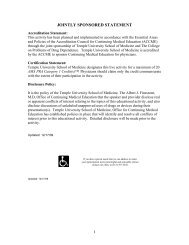
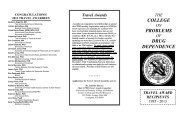
![2013SYMP AND WORKSHOP LIST[web]](https://img.yumpu.com/35325424/1/190x245/2013symp-and-workshop-listweb.jpg?quality=85)
